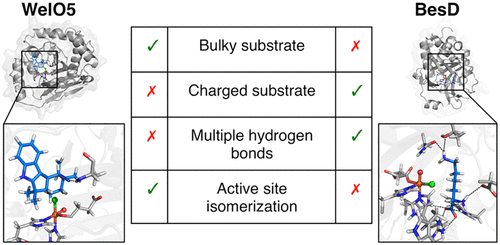当前位置:
X-MOL 学术
›
ACS Catal.
›
论文详情
Our official English website, www.x-mol.net, welcomes your feedback! (Note: you will need to create a separate account there.)
Spectroscopically Guided Simulations Reveal Distinct Strategies for Positioning Substrates to Achieve Selectivity in Nonheme Fe(II)/α-Ketoglutarate-Dependent Halogenases
ACS Catalysis ( IF 12.9 ) Pub Date : 2021-09-23 , DOI: 10.1021/acscatal.1c03169 Rimsha Mehmood 1, 2 , Vyshnavi Vennelakanti 1, 2 , Heather J. Kulik 1
ACS Catalysis ( IF 12.9 ) Pub Date : 2021-09-23 , DOI: 10.1021/acscatal.1c03169 Rimsha Mehmood 1, 2 , Vyshnavi Vennelakanti 1, 2 , Heather J. Kulik 1
Affiliation

|
Nonheme iron halogenases, such as SyrB2, WelO5, and BesD, halogenate unactivated carbon atoms of diverse substrates at ambient conditions with exquisite selectivity seldom matched by nonbiological catalysts. Using experimentally guided molecular dynamics (MD) simulations augmented with multiscale (i.e., quantum mechanics/molecular mechanics) simulations of substrate-bound complexes of BesD and WelO5, we investigate substrate/active-site dynamics that enable selective halogenation. Our simulations reveal that active-site configurational isomerization is necessary in WelO5 to attain a substrate/active-site geometry consistent with its observed chemo- and regioselectivity. Conversely, a slight reorientation of the substrate from its crystal structure position is sufficient to enable regioselective chlorination in BesD without the need to invoke active-site isomerization. We observe very different patterns of substrate–protein interactions for these two enzymes, and we relate the nature of these interactions to the distinct substrates. For BesD, we resolve the uncertainty around the mechanistic relevance of Asn219. Our simulations reveal that the optimum substrate/active-site geometry also outweighs the interactions between the metal-oxo and the protein environment in facilitating the required chemoselectivity in halogenases. Our work highlights how different substrate-dependent strategies are used to accomplish selectivity-promoting proximity in halogenases.
中文翻译:

光谱引导模拟揭示了定位底物以在非血红素 Fe(II)/α-酮戊二酸依赖性卤化酶中实现选择性的不同策略
非血红素铁卤化酶,如 SyrB2、WelO5 和 BesD,在环境条件下卤化不同底物的未活化碳原子,具有极好的选择性,很少与非生物催化剂相匹配。使用实验指导的分子动力学 (MD) 模拟,并辅以 BesD 和 WelO5 的底物结合复合物的多尺度(即量子力学/分子力学)模拟,我们研究了能够选择性卤化的底物/活性位点动力学。我们的模拟表明,在 WelO5 中,活性位点构型异构化是必要的,以获得与其观察到的化学和区域选择性一致的底物/活性位点几何形状。反过来,底物从其晶体结构位置的轻微重新定向足以在 BesD 中实现区域选择性氯化,而无需调用活性位点异构化。我们观察到这两种酶的底物-蛋白质相互作用的非常不同的模式,我们将这些相互作用的性质与不同的底物联系起来。对于 BesD,我们解决了 Asn219 机械相关性的不确定性。我们的模拟表明,在促进卤化酶所需的化学选择性方面,最佳底物/活性位点几何形状也超过了金属氧和蛋白质环境之间的相互作用。我们的工作强调了如何使用不同的底物依赖性策略来实现卤化酶的选择性促进接近。我们观察到这两种酶的底物-蛋白质相互作用的非常不同的模式,我们将这些相互作用的性质与不同的底物联系起来。对于 BesD,我们解决了 Asn219 机械相关性的不确定性。我们的模拟表明,在促进卤化酶所需的化学选择性方面,最佳底物/活性位点几何形状也超过了金属氧和蛋白质环境之间的相互作用。我们的工作强调了如何使用不同的底物依赖性策略来实现卤化酶的选择性促进接近。我们观察到这两种酶的底物-蛋白质相互作用的非常不同的模式,我们将这些相互作用的性质与不同的底物联系起来。对于 BesD,我们解决了 Asn219 机械相关性的不确定性。我们的模拟表明,在促进卤化酶所需的化学选择性方面,最佳底物/活性位点几何形状也超过了金属氧和蛋白质环境之间的相互作用。我们的工作强调了如何使用不同的底物依赖性策略来实现卤化酶的选择性促进接近。我们的模拟表明,在促进卤化酶所需的化学选择性方面,最佳底物/活性位点几何形状也超过了金属氧和蛋白质环境之间的相互作用。我们的工作强调了如何使用不同的底物依赖性策略来实现卤化酶的选择性促进接近。我们的模拟表明,在促进卤化酶所需的化学选择性方面,最佳底物/活性位点几何形状也超过了金属氧和蛋白质环境之间的相互作用。我们的工作强调了如何使用不同的底物依赖性策略来实现卤化酶的选择性促进接近。
更新日期:2021-10-01
中文翻译:

光谱引导模拟揭示了定位底物以在非血红素 Fe(II)/α-酮戊二酸依赖性卤化酶中实现选择性的不同策略
非血红素铁卤化酶,如 SyrB2、WelO5 和 BesD,在环境条件下卤化不同底物的未活化碳原子,具有极好的选择性,很少与非生物催化剂相匹配。使用实验指导的分子动力学 (MD) 模拟,并辅以 BesD 和 WelO5 的底物结合复合物的多尺度(即量子力学/分子力学)模拟,我们研究了能够选择性卤化的底物/活性位点动力学。我们的模拟表明,在 WelO5 中,活性位点构型异构化是必要的,以获得与其观察到的化学和区域选择性一致的底物/活性位点几何形状。反过来,底物从其晶体结构位置的轻微重新定向足以在 BesD 中实现区域选择性氯化,而无需调用活性位点异构化。我们观察到这两种酶的底物-蛋白质相互作用的非常不同的模式,我们将这些相互作用的性质与不同的底物联系起来。对于 BesD,我们解决了 Asn219 机械相关性的不确定性。我们的模拟表明,在促进卤化酶所需的化学选择性方面,最佳底物/活性位点几何形状也超过了金属氧和蛋白质环境之间的相互作用。我们的工作强调了如何使用不同的底物依赖性策略来实现卤化酶的选择性促进接近。我们观察到这两种酶的底物-蛋白质相互作用的非常不同的模式,我们将这些相互作用的性质与不同的底物联系起来。对于 BesD,我们解决了 Asn219 机械相关性的不确定性。我们的模拟表明,在促进卤化酶所需的化学选择性方面,最佳底物/活性位点几何形状也超过了金属氧和蛋白质环境之间的相互作用。我们的工作强调了如何使用不同的底物依赖性策略来实现卤化酶的选择性促进接近。我们观察到这两种酶的底物-蛋白质相互作用的非常不同的模式,我们将这些相互作用的性质与不同的底物联系起来。对于 BesD,我们解决了 Asn219 机械相关性的不确定性。我们的模拟表明,在促进卤化酶所需的化学选择性方面,最佳底物/活性位点几何形状也超过了金属氧和蛋白质环境之间的相互作用。我们的工作强调了如何使用不同的底物依赖性策略来实现卤化酶的选择性促进接近。我们的模拟表明,在促进卤化酶所需的化学选择性方面,最佳底物/活性位点几何形状也超过了金属氧和蛋白质环境之间的相互作用。我们的工作强调了如何使用不同的底物依赖性策略来实现卤化酶的选择性促进接近。我们的模拟表明,在促进卤化酶所需的化学选择性方面,最佳底物/活性位点几何形状也超过了金属氧和蛋白质环境之间的相互作用。我们的工作强调了如何使用不同的底物依赖性策略来实现卤化酶的选择性促进接近。



























 京公网安备 11010802027423号
京公网安备 11010802027423号